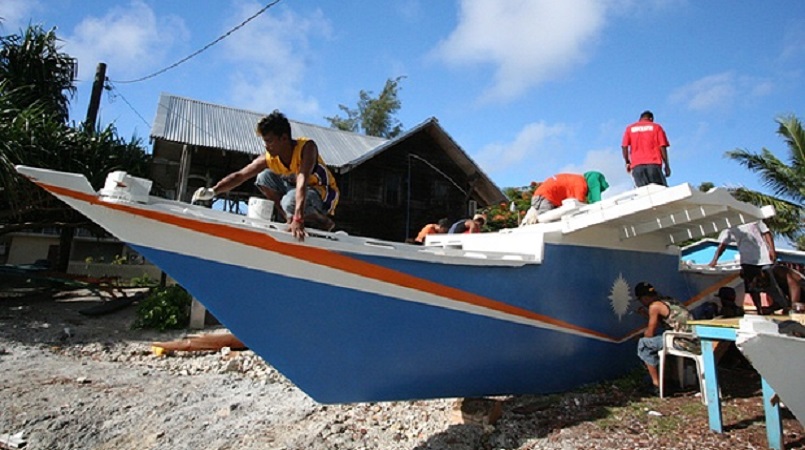
A few metres from turquoise lagoon waters that have sustained Marshall Islanders with marine life for two millennia, the steady sound of saws slicing into wood can be heard from inside a two-storey timber building.
But at the Waan Aelon in Majel training centre, the sounds signify more than simply carpenters at work: here, young people who left school before the age of 13 are learning to build outrigger canoes as they immerse themselves in the culture of their ancestors.
“A hundred years ago, everyone had a position in life as fishermen, weavers and local medicine experts,” says Alson Kelen, who has directed the youth programme at the training centre for 20 years. “Everyone participated in the culture. Today, kids are lost – they don’t know where to fit in.”
For Kelen, addressing issues of cultural identity while developing practical vocational skills is key to the success of his programme for out-of-school Marshall Islanders. “They can go western and get more education or a job, but they also know who they are, and can go to an outer island and have the subsistence skills to live,” he says.
School dropout rates are high in urban areas of the Marshall Islands, where 75% of the population of 53,000 live. Youth unemployment is estimated at 60% in these areas of the islands, which are located near the equator in the Pacific Ocean.
The canoe building programme and other community projects aim to harness local culture and traditions to equip younger generations to succeed in a country that – like other Pacific nations – has a high dependency on aid.
“Aid dependency here is a problem,” says Kelen. “In government, all the talk is about aid, how much we can get, not about implementing projects that produce results.”
The eighth millennium development goal (MDG) included a target on increasing aid to small island developing nations, and aid to the region has gone up as a result: official development assistance (ODA) to the 14 Pacific nations has doubled since 2002, with two-thirds directed to social infrastructure and services such as education, health, water and sanitation.
Despite this increase, progress on the MDGs remains mixed. By 2013, only two Pacific Island countries – Cook Islands and Niue – were on track to achieve MDG1 of halving extreme poverty and hunger. On many islands, education and health indicators have declined, while levels of domestic violence remain high. Overall, progress on the MDGs for the Pacific Islands is not positive. Ten of the nations were unable to achieve a majority of the eight MDGs, and three failed to successfully implement a single one.
Rising poverty, government corruption and an epidemic of lifestyle diseases dominate daily life for an increasing number of Marshall Islanders. Sixty years ago, diabetes was virtually unheard of here, but today the country is among the 10 most obese nations globally. In fact, nine out of 10 countries on the World Health Organisation’s list of top obese nations are in the Pacific.
As across the Pacific, the Marshall Islands are also grappling with the rising ocean, among the first effects of climate change.
Last year, Australia’s foreign minister, Julie Bishop, spoke bluntly about the lack of results from her government’s foreign aid to the region. “I find it distressing to know that despite the fact that Australia invests about half a billion dollars every year into Papua New Guinea, it will not meet one of its millennium development goals— in fact, it is going backwards,” she said.
Kelen believes the key to providing young urban Marshall Islanders with a sustainable future is giving them a strong cultural foundation. “Many youth just play ukeleles all day, talk, or drink alcohol,” says Kelen, whose team of master canoe builders, teachers and counsellors provide six months of life skills and vocational training.
“Now [after the training], the youth are saying things like, ‘can you help me with a resume?’ There is something productive in their lives. They are thinking about jobs, higher education and training in other places,” he says.
It is a philosophy that some say is not shared by Pacific governments or donors, who have preferred to opt for modern solutions – which have borne scant results. This year, one government official in the Marshalls said the country needed more aid to implement human rights improvements in response to the UN Universal Periodic Review every five years.
But others see it differently, including Kathryn Relang, who directs the national women’s organisation (Wutmi) in the Marshall Islands. “I think it is just a matter of our own capacity and willingness to take on these issues,” said Relang.
Implementing 17 new sustainable development goals from 2016 is a concern among NGOs, who fear island governments will repeat mistakes made in delivering the MDGs. They are calling on governments and their donors to reinvent their development agendas and means of implementation.
Kelen believes island culture holds the key to sustainable development. “Some see the outrigger canoe as a thing of the past, but it’s a tool that has survived 2,000 years and it will survive 2,000 more,” he says. “Sustainable livelihoods start from our traditions.”
